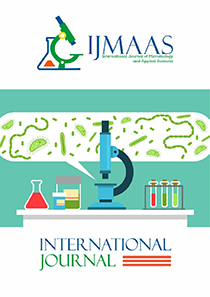Impact of Various Slime Removal Treatment and Antibiogram of Bacterial Isolates from Snails (Achatina fulica) Harvested in Port Harcourt Metropolis
Vol. 3, Issue 2, 2024
KEYWORDS
Snail (Achatina fulica), slime removal, vinegar, noni, alum, haemolysis, biofilm, virulence, antibiogram
Abstract
Snail meat is an alternative source of protein to those from animal origin and highly consumed worldwide. Snails absorb a variety of substances, and harbors significant microbiota which can act as a medium for the spread of infectious agents to consumers. This study evaluates the effect of different slime removal agents (Alum, Vinegar and Noni leaf extract) on microbial load and antibiogram of bacteria from snail (Achatina fulica) in Port Harcourt using standard microbiological methods. Results showed mean range of total heterotrophic bacterial, total coliform count, faecal coliform count and total Salmonella/Shigella count for the control and wild snail were; 1.45±0.35 – 10.70±2.12CFU/g, 1.55±0.35-8.70±0.85, 2.15±0.49- 11.80±1.98, and 2.50±1.13-20.40±1.69CFU/g respectively. The wild snail sample recordeed the highest microbial load for all the bacteria groups. Alum recorded the highest bacteria removal and hence lowest count with mean ranges from 1.45±0.35 to 7.50±0.71 CFU/g; Vinegar ranging from 2.55±0.49 to 11.40±1.41 CFU/g and the least being Noni leaf extract 2.55±0.21 to 11.80±1.98CFU/g. Bacteria isolated were; Bacillus, Escherichia, Micrococcus, Pseudomonas, Klebsiella, Staphylococcus, Salmonella, and Shigella. The molecular characterization of isolates showed Pseudomonas sp had 83.4% relatedness to Pseudomonas aeruginosa (EU373426), Bacillus sp had 90.79% to Bacillus cereus (ON763803), Staphylococcus sp had 99.16% to Staphylococcus warneri (MK256311), Aeromonas sp had 73.1% to Aeromonas hydrophila (OR364740) and Shigella sp had 96.96% to Shigella flexneri (OK326507). Virulence results showed that Bacillus sp. was 66.7% biofilm positive and 33.3% haemolysis positive, E. coli was 66.7% and 66.7%, Micrococcus was 0% and 100%, Pseudomonas sp was 100% and 0%, Klebsiella, was 0% and 50%, Staphylococcus sp was 100% and 66.7%, Salmonella and Shigella sp were 0% and 100% positive for biofilm and haemolysis production respectively. Nitrofurantoin, Levofloxacin, Ofloxacin and Nalidixic acid were the most potent antibiotics and Pseudomonas and Salmonella were the most resistant isolates. The organisms isolated from this study were potential pathogens and have the ability to cause disease which may result in food poisoning. It is imperative to ensure adequate care in the preparation of snails so that their consumption will not cause serious epidemic threat.
Current: Vol. 4, Issue 1, 2025

Call for papers
The International Journal of Microbiology and Applied Sciences warmly welcome your valuable articles for publication.
